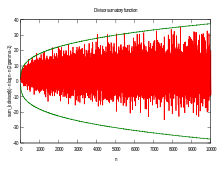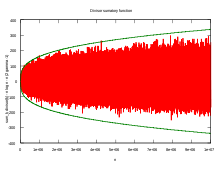- Divisor summatory function
-
In number theory, the Divisor summatory function is a function that is a sum over the divisor function. It frequently occurs in the study of the asymptotic behaviour of the Riemann zeta function. The various studies of the behaviour of the divisor function are sometimes called divisor problems.
Contents
Definition
The divisor summatory function is defined as
where
is the divisor function. The divisor function counts the number of ways that the integer n can be written as a product of two integers. More generally, one defines
where dk(n) counts the number of ways that n can be written as a product of k numbers. This quantity can be visualized as the count of the number of lattice points fenced off by a hyperbolic surface in k dimensions. Thus, for k=2, D(x)=D2(x) counts the number of points on a square lattice bounded on the left by the vertical-axis, on the bottom by the horizontal-axis, and to the upper-right by the hyperbola jk = x. Roughly, this shape may be envisioned as a hyperbolic simplex. This allows us to provide an alternative expression for D(x), and a simple way to compute it in
 time:
time: , where
, where 
If the hyperbola in this context is replaced by a circle then determining the value of the resulting function is known as the Gauss circle problem.
Dirichlet's divisor problem
Finding a closed form for this summed expression seems to be beyond the techniques available, but it is possible to give approximations. The leading behaviour of the series is not difficult to obtain. Dirichlet demonstrated that
where γ is the Euler-Mascheroni constant, and the non-leading term is
Here,
 denotes Big-O notation. The Dirichlet divisor problem, precisely stated, is to find the infimum of all values θ for which
denotes Big-O notation. The Dirichlet divisor problem, precisely stated, is to find the infimum of all values θ for whichholds true, for any ε > 0. As of 2006[update], this problem remains unsolved. Progress has been slow. Many of the same methods work for this problem and for Gauss's circle problem, another lattice-point counting problem. Section F1 of Unsolved Problems in Number Theory [1] surveys what is known and not known about these problems.
- In 1904, G. Voronoi proved that the error term can be improved to
 [2]:381
[2]:381 - In 1916, G.H. Hardy showed that
 . In particular, he demonstrated that for some constant K, there exist values of x for which Δ(x) > Kx1 / 4 and values of x for which Δ(x) < − Kx1 / 4.[3]:69
. In particular, he demonstrated that for some constant K, there exist values of x for which Δ(x) > Kx1 / 4 and values of x for which Δ(x) < − Kx1 / 4.[3]:69 - In 1922, J. van der Corput improved Dirichlet's bound to
 [2]:381
[2]:381 - In 1928, J. van der Corput proved that
 [2]:381
[2]:381 - In 1950, Chih Tsung-tao and independently in 1953 H. E. Richert proved that
 [2]:381
[2]:381 - In 1969, Grigori Kolesnik demonstrated that
 .[2]:381
.[2]:381 - In 1973, Grigori Kolesnik demonstrated that
 .[2]:381
.[2]:381 - In 1982, Grigori Kolesnik demonstrated that
 .[2]:381
.[2]:381 - In 1988, H. Iwaniec and C. J. Mozzochi proved that
 [4]
[4] - In 2003, M.N. Huxley improved this to show that
 [5]
[5]
So, the true value of inf θ lies somewhere between 1/4 and 131/416; it is widely conjectured to be exactly 1/4. Direct evaluation of Δ(x) lends credence to this conjecture, since Δ(x) / x1 / 4 appears to be approximately normally distributed with the standard deviation of 1 for x up to at least 1016.
Generalized divisor problem
In the generalized case, one has
where Pk is a polynomial of degree k − 1. Using simple estimates, it is readily shown that
for integer
 . As in the k = 2 case, the infimum of the bound is not known. Defining the order θk as the smallest value for which
. As in the k = 2 case, the infimum of the bound is not known. Defining the order θk as the smallest value for whichholds, for any
 , one has the following results:
, one has the following results:- Voronoi and Landau,
 for
for 
- Hardy and Littlewood,
 for
for 
- Hardy showed that
 for
for 
- E.C. Titchmarsh conjectures that

Mellin transform
Both portions may be expressed as Mellin transforms:
for c > 1. Here, ζ(s) is the Riemann zeta function. Similarly, one has
with
 . The leading term of D(x) is obtained by shifting the contour past the double pole at w = 1: the leading term is just the residue, by Cauchy's integral formula. In general, one has
. The leading term of D(x) is obtained by shifting the contour past the double pole at w = 1: the leading term is just the residue, by Cauchy's integral formula. In general, one hasand likewise for Δk(x), for
 .
.Notes
- ^ Guy, Richard K. (2004). Unsolved Problems in Number Theory (3rd ed.). Berlin: Springer. ISBN 9780387208602.
- ^ a b c d e f g Ivic, Aleksandar (2003). The Riemann Zeta-Function. New York: Dover Publications. ISBN 0486428133.
- ^ Montgomery, Hugh; R. C. Vaughan (2007). Multiplicative Number Theory I: Classical Theory. Cambridge: Cambridge University Press. ISBN 9780521849036.
- ^ Iwaniec, H.; C. J. Mozzochi (1988). "On the divisor and circle problems". Journal of Number Theory 29: 60–93. doi:10.1016/0022-314X(88)90093-5.
- ^ Huxley, M. N. (2003). "Exponential sums and lattice points III". Proc. London Math. Soc. 87 (3): 591–609. doi:10.1112/S0024611503014485.
References
- H.M. Edwards, Riemann's Zeta Function, (1974) Dover Publications, ISBN 0-486-41740-9
- E. C. Titchmarsh, The theory of the Riemann Zeta-Function, (1951) Oxford at the Clarendon Press, Oxford. (See chapter 12 for a discussion of the generalized divisor problem)
- Apostol, Tom M. (1976), Introduction to analytic number theory, Undergraduate Texts in Mathematics, New York-Heidelberg: Springer-Verlag, ISBN 978-0-387-90163-3, MR0434929 (Provides an introductory statement of the Dirichlet divisor problem.)
- H. E. Rose. A Course in Number Theory., Oxford, 1988.
- M.N. Huxley (2003) 'Exponential Sums and Lattice Points III', Proc. London Math. Soc. (3)87: 591-609
Categories:- Arithmetic functions
- Lattice points
- Unsolved problems in mathematics
Wikimedia Foundation. 2010.















